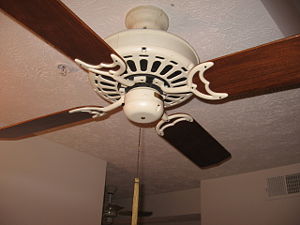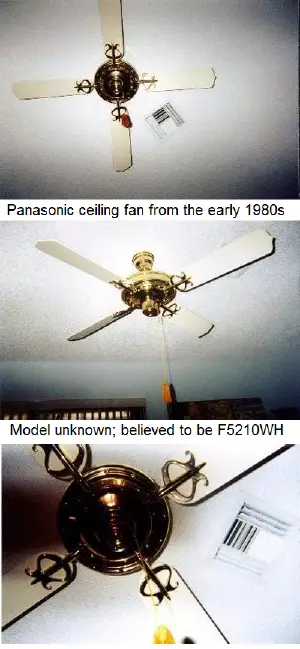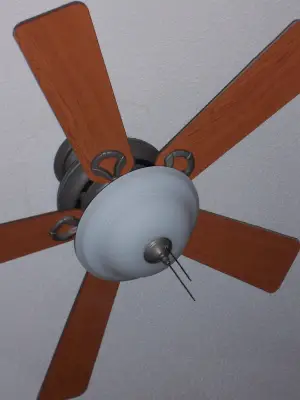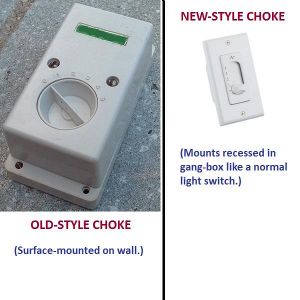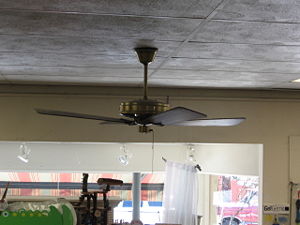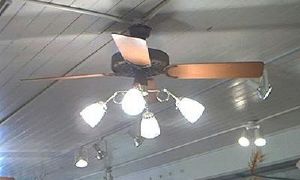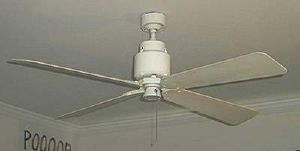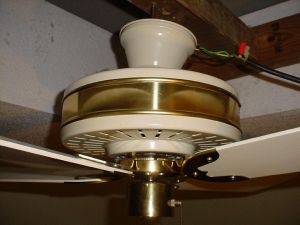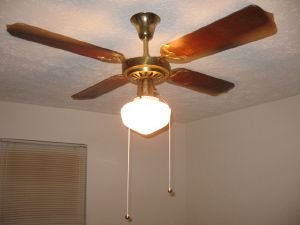Ceiling fan
A ceiling fan is a device suspended from the ceiling of a room, with hub-mounted rotating blades that circulate the air, thereby producing a cooling or destratification effect. Most ceiling fans have an electrical switch that allows one to reverse the direction of rotation of the blades.
In the summer, the direction of rotation of the blades is set to blow air downward, so that the breeze created evaporates sweat on a person's skin and the person experiences a cooling effect. In the winter, the direction of rotation of the blades is reversed, so that cooler air (which normally sinks to the floor) is drawn upward, and warmer air that is near the ceiling is made to circulate downward. In this manner, a ceiling fan can be useful during both hot and cold seasons.
History
The first ceiling fans appeared in the 1860s and 1870s, in the United States. At that time, they were not powered by any form of electric motor. Instead, a stream of running water was used, in conjunction with a turbine, to drive a system of belts which would turn the blades of two-blade fan units. These systems could accommodate several fan units, and so became popular in stores, restaurants, and offices. Some of these systems still survive today, and can be seen in parts of the southern United States where they originally proved useful.
The electrically-powered ceiling fan was invented in 1882 by Philip Diehl (pronounced the same as "deal"). Diehl had engineered the electric motor used in the first Singer sewing machines, and in 1882 adapted that motor for use in a ceiling-mounted fan. "The Diehl Electric Fan," as it was known, operated like a common modern-day ceiling fan; each fan had its own self-contained motor unit, eliminating the need for costly and bulky belt systems.[1]
Diehl was, almost immediately, up against fierce competition due to the commercial success of the ceiling fan. However, he continued to make improvements to his invention. One such improvement, the "Diehl Electrolier," was a light kit adapted onto the ceiling fan to compensate for any light fixture(s) displaced by the installation of the ceiling fan, and/or to add extra overhead lighting to the room.
By World War I, most ceiling fans were being manufactured with four blades instead of the original two. Besides making fans quieter, this change allowed them to circulate more air, thereby making more efficient use of their motors.
By the 1920s, ceiling fans had become commonplace in the United States, and had started to take hold internationally; however, during the Great Depression, ceiling fans faded out of vogue in the U.S.[1] By the end of World War II, ceiling fans had become almost non-existent, and remained that way into the 1950s. Those which remained were considered items of nostalgia. However, the ceiling fan was still very popular in other countries, notably those with warm climates which could not afford high-energy-consuming devices, namely air conditioning.
In the 1960s, some Oriental manufacturers started exporting their ceiling fans to the United States. They caught on slowly at first, but found great success during the energy crisis of the late 1970s, since ceiling fans consume far less energy than air conditioning units.
Due to this renewed commercial success, many American manufacturers started to produce (or significantly increase production of) ceiling fans, resulting in a revival of interest in the product. The well-known Casablanca Fan Company was founded in 1974. Other popular American manufacturers at the time included the Hunter Fan Co. (which was then a division of Robbins & Myers, Inc), FASCO (F. A. Smith Co.), Emerson Electric, and Lasko; the latter two were often relabeled and sold by Sears-Roebuck.
During the rest of the 1970s, and through to the late 1980s, ceiling fans remained popular in the American market. Many small American manufacturers, most of them rather short-lived, started making ceiling fans. Throughout the 1980s, the balance of sales between American-made ceiling fans and those imported from Asian manufacturers changed dramatically. The high cost of American parts and labor became prohibitive for many consumers (for example, a basic American-made ceiling fan could cost anywhere from $100 to $250, whereas the cost of the fanciest imported fans rarely exceeded $85).
Due to the ever-reducing cost of amenities such as air conditioning, ceiling fan sales once again started to decline, beginning in the early- to mid-1990s. With the reduction in sales came a reduction in research and development, as well as features. Once-standard features (such as solid wood blades, built-in variable-speed dials, high-quality stator/rotor ("stack") motors, and die-cast steel construction) have been largely replaced by cheap, standardized parts.
Since 2000 there has been important inroads made by companies offering higher price ceiling fans with more decorative value. In 2001, Washington Post writer Patricia Dane Rogers[2] wrote, âLike so many other mundane household objects, these old standbys are going high-style and high-tech.â Newer companies such as Minka, Fanimation, The Modern Fan Co., The Period Arts Fan Co. and Monte Carlo brought well-built fans with distinctive design to the market.
Parts of a ceiling fan
The key components of a ceiling fan are the following:
- An electric motor (see Types of ceiling fans below for descriptions)
- One to six paddles (called "blades"); usually made of wood, MDF, metal, or plastic; which mount under, on top of, or on the side of the motor. The majority of residential ceiling fans have either four or five blades, while most industrial ceiling fans have three. However, a very few specialized art fans (fans made more for artistic appearance than functionality) have other numbers of blades, such as one, or eight or more.
- Metal arms, called blade irons (alternately blade brackets, blade arms, blade holders, or flanges), which connect the blades to the motor.
- Rotor, alternative to blade irons. First patented by industrial designer Ron Rezek in 1991, the one-piece die cast rotor receives and secures the blades and bolts right to the motor, eliminating most balance problems and minimizes exposed fasteners.
- A mechanism for mounting the fan to the ceiling
- Some fans mount using a "ball-and-socket" system. With this system, there is a metal or plastic hemisphere mounted on the end of the downrod; this hemisphere rests in a ceiling-mounted metal bracket and allows the fan to move freely (which is very useful on vaulted ceilings). Some companies have come up with slight modifications of this design.
- Some fans mount using a "J-hook" (also known as a "claw-hook") system. In this system, a metal hook (which comes in a variety of configurations) secures to a ceiling-mounted metal bolt (again, available in a variety of configurations). Usually, there is a rubber bushing inserted between the hook and the bolt as a noise-reduction agent.
- Some fans can be mounted using a Low-Ceiling Adapter, a special kit which must be purchased from the fan's manufacturer. This eliminates the need for a downrod, and is therefore useful in rooms with low ceiling clearance.
- In recent years, it has become increasingly common for a ball-and-socket fan to be designed such that the canopy (ceiling cover piece) can optionally be screwed directly into the top of the motor housing; then the whole fan can be secured directly onto the ceiling mounting bracket. This is known as a "close-to-ceiling" mount.
Other components, which vary by model and style, can include:
- A downrod, a metal pipe used to suspend the fan from the ceiling. Downrods come in many lengths.
- A decorative encasement for the motor (known as the "motor housing").
- A switch housing (also known as a "switch cup"), a metal cylinder mounted below and in the center of the fan's motor. The switch housing is used to conceal and protect various components, which can include wires, capacitors, and switches; on fans that require oiling, it often conceals the oil reservoir which lubricates the bearings. The switch housing also makes for a convenient place to mount a light kit.
- Blade badges, decorative adornments attached to the visible underside of the blades for the purpose of concealing the screws used to attach the blades to the blade irons.
- Assorted switches used for turning the fan on and off, adjusting the speed at which the blades rotate, changing the direction in which the blades rotate, and operating any lamps that may be present.
- Lamps
- Uplights, which are installed on top of the fan's motor housing and project light up onto the ceiling, for aesthetic reasons (to "create ambiance")
- Downlights, often referred to as a "light kit," which add ambient light to a room and can be used to replace any ceiling-mounted lamps that were displaced by the installation of a ceiling fan
- Decorative light bulbs mounted inside the motor housingâin this type of setup, the motor housing often has glass panel sections which allow light to shine though.
Configurations
- Commercial or industrial ceiling fans are usually used in offices, factories or industries. Commercial ceiling fans are designed to be cost effective and can save more than 75 percent on energy savings, which is always welcome in businesses. The industrial or commercial ceiling fans only use three blades plus a high-speed motor to function. To use more blades would strain the motor and use up more electricity. It can be purchased with an ultra quiet motor. These energy efficient ceiling fans push massive amounts of air compared traditional ceiling fan. If itâs summer they keep the air circulating and in winter they push warm air from the ceiling to the floor.
- A hugger or low profile ceiling fan has been installed as close as possible to the surface of the ceiling without the ceiling fan blades scraping it. Hugger fans are usually installed in rooms which have lower ceilings. Hugger ceiling fans canât be used in rooms with vaulted ceilings. In cold climates, a ceiling fan may disperse heat to warm up the room as well by dispersing downwards the warm air that rises to the ceiling surface. Though the ceiling fan cannot lower room temperatures, when used in tandem with a room air-conditioner it may be able to disperse the cool air all around the room.
- Outdoor ceiling fans may be used in covered locations but outside the house proper, such as in a porch exposed to the garden. The outdoor ceiling fan should never be placed where the elements (especially water) can reach it and its motor. Outdoor ceiling fan should be covered with a rust-proof finish and non-warp blades. Outdoor fans are made of materials which can withstand cold, heat and humidity.
- Energy star ceiling fans are manufactured under the energy star label. Usually energy star fans hold the distinction of being more energy efficient (50 percent), have lower price tags, and save a lot of money on energy savings. There are also energy star ceiling fans cooling other types of structures besides home such as warehouses, offices, businesses, and schools. Energy star ceiling fans are available in home repair stores and furniture stores, or you may order the product online at a discount online store.
Operating a ceiling fan
The way in which a fan is operated depends on its manufacturer, style, and the era in which it was made. Operating methods include:
- Pull-chain/pull-cord control. This is the most common method of operation for household fans. This style of fan is equipped with a metal-bead chain or cloth cord which, when pulled, cycles the fan through the operational speed(s) and then back to off. These fans typically have three speeds (high, medium, and low); however, the speed range can be anywhere from one through four.
- Variable-speed control. During the 1970s and 1980s, fans were often produced with a variable-speed control. This was a dial mounted on the fan which, when turned in either direction, continuously varied the speed at which the blades rotatedâsimilar to a dimmer switch for a light fixture. A few fans substituted a rotary click-type switch for the infinite-speed dial, providing a set number of speeds (usually five).
- Different fan manufacturers used the variable-speed control in different ways:
- The variable-speed dial controlling the fan entirely; to turn the fan on, the user turns the knob until it clicks out of the "off" position, and can then choose the fan's speed.
- A pull-chain present along with the variable-speed control; the dial can be set in one place and left there, with the pull-chain serving only to turn the fan on and off. Many of these fans have an option to wire the light kit to this pull-chain in order to control both the fan and the light with one chain. Using this method, the user can have either the fan or light on individually, both on, or both off.
- "Vari-Low:" A pull-chain and variable-speed control are present. Such a fan has two speeds controlled by a pull-chain: high (full power, independent of the position of the variable-speed control), and variable (speed determined by the position of the variable-speed control).
- Different fan manufacturers used the variable-speed control in different ways:
- Wall-mounted control. Some fans have their control(s) mounted the wall instead of on the fans themselves; such controls and are usually proprietary and/or specialized switches.
- Digital control: With this style of control, all of the fan's functionsâon/off status, speed, direction of rotation, and any attached light fixturesâare controlled by a computerized wall control, which typically does not require any special wiring. Instead, it uses the normal house wiring to send coded electrical pulses to the fan, which decodes and acts on them using a built-in set of electronics. This style of control typically has anywhere from three to six speeds.
- Choke. This style of switch takes varying physical forms. The wall control, which contains a resistor of some sort, determines how much power is delivered to the fan and therefore how fast it spins. Older incarnations of this type of control employed an iron-core transformer as their resistor; these controls were typically large, boxy, and surface-mounted on the wall. Those controls had anywhere from four to eight speeds, typically four or five. Newer versions of the choke-style control employ electronic equipment as their resistor; this is much smaller, so the switch is typically mounted in a standard in-wall gang box; these typically have four speeds.
- Wireless remote control. In recent years, remote controls have become an affordable option for controlling ceiling fans. While some models do employ this as their sole form of operation, it is more common for a person to purchase an after-market kit and install it on an existing fan. The hand-held remote transmits radio frequency or infrared signals to a receiver unit installed in the fan, which interprets and acts on the signals.
Bases for comparison
There are several factors which determine a fan's efficacy and efficiency. Each of these factors can be used as a basis for comparison when deciding between different candidate fans to purchase.
A fan's efficacy (in other words, its ability to generate airflow) is measured by its CFM (Cubic Feet of air moved per Minute) rating. The following factors all have an effect on a fan's CFM rating:
- Length of the fan's blades. The longer a fan's blades are, the larger percentage of a room's air volume upon which the fan will have a relevant impact. This factor is of greater importance in large rooms. The majority of ceiling fans come in one of three sizes (sweep diameter): 36," 42," or 52."
- Total surface area of the fan's blades. The greater a blade's surface area, the more air it is able to move. However, there can be "too much" surface area (refer to Blade surface area to air-feed ratio below).
- Pitch of the fan's blades. The angle at which the fan's blades are tilted relative to the X-axis is referred to as the "blade pitch." The steeper (greater) the pitch, the greater the airflow. Since increased pitch also means increased drag, only fans with well-made motors can support steep pitches. Cheaply-made fans typically have a pitch between 9 and 13 degrees. A pitch of 15 degrees and upwards is considered very good, with numbers in the 20s being the highest.
- Speed of rotation. The speed at which a fan rotates, measured in RPM (Revolutions Per Minute), directly correlates to the amount of air moved. Faster rotation equals greater airflow.
- Blade surface area to air-feed ratio. In general, more blade surface area means greater airflow. However, if there is too much blade surface area, there will not be adequate space between the blades for air to be drawn through. Fans which have an unusually large blade surface area, such as fans with decorative palm-leaf-style blades or many fans with six blades, do not have adequate space between the blades for an unrestricted amount of air to be drawn through. This results in reduced airflow. The effect of this ranges from negligible to dramatic, depending on the exact dimensions involved. Contrary to popular belief, more blades typically does not equal more airflow. Most four-bladed fans move more air than comparable five-bladed fans spinning at the same speed; this is indeed noticeable on five-bladed fans which have an option to install only four of the blades. Also due to this effect, the overwhelmingly vast majority of industrial fans have three blades.
- Height of the fan relative to the ceiling. If a fan is too close to the ceiling, the airflow is restricted; that is, the fan will not be able to draw as much air through its blades as it has the potential to do. For this reason, "hugger"-style fans (those which mount directly to the ceiling without the use of a downrod) are all inherently disadvantaged. The distance that a fan should be mounted from the ceiling is directly correlated with its air-moving potential; no fan should be mounted with its blades closer than 24Â inches (610Â mm) to the ceiling, however that figure is often far greater with industrial fans. Unfortunately, this is often impossible in household situations due to the fact that a minimum ceiling height of nine feet would be required to meet safety codes ("blades must be mounted a minimum of seven feet from the floor," and 8 or more feet is typically desired).
In addition to all of the aforementioned factors, there are certain other factors which have an effect on a fan's perceived efficacy (how efficacious an observer experiences a fan as being):
- Height of the fan relative to the observer. The closer the fan is to the observer, the more air movement the observer will feel. A fan mounted close to the ceiling in a high-ceiling room will have a lower perceived efficacy than if it were mounted closer to the ground.
- Tilt of the fan's blades relative to the vertical Z-axis. A few fan manufacturers, notably FASCO, constructed their fans such that the blades had an "up-tilt"; that is, they were tilted relative to the Z-axis (see picture at right). While this increased the area of the room over which the fan had a direct effect, thereby increasing the efficacy perceived by persons standing at the edges of the room, it decreased the airflow concentrated immediately under the fan, thereby reducing the efficacy perceived by anyone standing/sitting directly underneath it. Some industrial ceiling fans have the tips of the blades bent to the Z-axis so that the area of the room over which the fan has a direct will be greater. The perceived efficacy directly under one of these fans is not affected as much as if the entire blade were tilted relative to the Z-axis.
- Humidity of the room. Since a fan creates its cooling effect by speeding the evaporation of moisture (both sweat and ambient humidity) on human skin, its perceived efficacy is directly correlated with the amount of humidity (moisture) in the room. In dry environments, such as desert climates, a fan has a lesser perceived efficacy than in humid environments; this is especially notable during cold weather, where a humid environment has a pronounced wind-chill effect which is lacking in dry environments.
In terms of efficiency (in other words, airflow generated versus energy input), the basis for comparison is to divide the fan's CFM rating by its input wattage. So, if the fan moves 6630 CFM on its highest speed, and uses 85 watts to do so, its energy efficiency is 78. A consumer can apply that same equation to several candidate fans to objectively compare their energy efficiency. The U.S. Department of Energy now requires that this efficiency number appears on the box to facilitate the consumers choice.
Types of ceiling fans
Many styles of ceiling fans have been developed over the years, in response to several different factors such as growing energy-consumption consciousness and changes in decorating styles. The advent and evolution of electronic technology has also played a major role in ceiling fan development. Following is a list of major ceiling fan styles and their defining characteristics:
- Cast-iron ceiling fans. Cast-iron ceiling fans account for almost all ceiling fans made from their invention in 1882 through the 1950s. A cast-iron housing encases a very heavy-duty oil-bath motor, usually of the shaded-pole variety. These fans must be oiled periodically, usually once or twice per year, since they use an oil-bath system for lubrication. Because these fans are so sturdily built, and due to their utter lack of electronic components, it is not uncommon to see cast-iron fans aged eighty years or more running strong and still in use today.
- The Hunter 'Original' (see picture at right) (manufactured by the Hunter Fan Co., formerly a division of Robbins & Myers, Inc.) is an example of a cast-iron ceiling fan. It has enjoyed the longest production run of any fan in history, dating from 1906 to the present (it is still being manufactured as the "Classic Original," with several spin-off models). The Original employed a shaded-pole motor from its inception until the late 1980s, at which point it was changed to a permanent split-capacitor motor. Though the fan's physical appearance remained unchanged, the motor was further downgraded in 2002 when production was shipped overseas; the motor, though still oil-lubricated, was switched to a "skeletal" design, as discussed below.
- Stack-motor ceiling fans. In the late 1970s, due to rising energy costs prompted by the energy crisis, Emerson invented a new style of electric motor designed specifically for ceiling fans, the "stack" motor. This powerful, energy-efficient motor aided in the comeback of ceiling fans in America, since it was far less expensive to operate than air conditioning. With this design (which consists of a basic stator and squirrel-cage rotor), the fan's blades mount to a central hub, known as a flywheel. The flywheel can be made of either metal or reinforced rubber, and can be mounted either flush with the fan's motor housing (concealed) or prominently below the fan's motor housing (known as a "dropped flywheel"). Many manufacturers used and/or developed their own stack motors, including (but not limited to) Casablanca, Emerson, FASCO, Hunter, and NuTone. Some manufacturers trademarked their personal incarnation of this motor: for example, Emerson came out with the "K-55" and "K-63" motors, and Casablanca with the "XLP-2000." One of the earliest stack-motor fans was the Emerson "Heat Fan," aka the "Blender Fan" (see picture at left), a utilitarian fan with a dropped flywheel and blades made of fiberglass or plastic. This fan was produced from 1976 through 1983 and, while targeted at commercial settings, also found great success in residential settings. Another stack-motor fan; one without the dropped flywheel; is the Casablanca "Delta" pictured at the beginning of this article. While this motor is not nearly as widely used as in the 1970s and 1980s, it can still be found in certain high-end Casablanca and Emerson fans.
One disadvantage of this type of fan is that the flywheel, if it is made from rubber, will dry out and crack over time and eventually break; this is usually not dangerous, but it renders the fan inoperable until the flywheel is replaced.
- Direct-drive ceiling fans employ a motor with a stationary inner core with a shell that revolves around it (commonly called a "spinner" or "pancake" motor); the blades attach to this shell. Direct-drive motors are the least expensive motors to produce, and on the whole are the most prone to failure and noise generation.[1] While the very first motors of this type (first used in the 1960s) were relatively heavy-duty, the quality of these motors has dropped significantly in recent years. This type of motor has become the standard for today's fans; it has been (and is) used in all Hampton Bay and Harbor Breeze ceiling fans, and has become commonly used by all other brands.
- Spinner fans employ a direct-drive motor and do not have a stationary decorative cover (motor housing). This accounts for most industrial-style fans (though such fans sometimes have more moderate-quality motors), and some inexpensive residential-style fans (particularly those made overseas).
- Spinner-motor fans, sometimes confusingly (and incorrectly) referred to as "spinners," employ a direct-drive (spinner) motor and do have a stationary decorative cover (motor housing). "Spinner-motor" fans account for nearly all fans manufactured from the late 1980s to the present, including nearly all fans made overseas.
- Skeletal motors, which are a high-quality subset of direct-drive motors, can be found on some nicer fans. Examples of skeletal motors include Hunter's "AirMax" motor, Casablanca's "XTR200" motor, and the motors made by Lasko for use in their ceiling fans. Skeletal motors differ from regular direct-drive motors in that:
- They have an open ("skeletal") design, which allows for far better ventilation and therefore a longer lifespan. This is in comparison to a regular direct-drive motor's design, in which the motor's inner workings are completely enclosed within a tight metal shell which may or may not have openings for ventilation; when openings are present, they are almost always small to the point of being inadequate.
- They are larger than regular direct-drive motors and, as a result, are more powerful and less prone to burning out.
- Friction-drive ceiling fans. This short-lived type of ceiling fan was attempted by companies such as Emerson and NuTone in the late 1970s with little success. Its advantage was its tremendously low power consumption, but the fans were unreliable and very noisy, in addition to being grievously underpowered. Friction-drive ceiling fans employ a low-torque motor that is mounted transversely in relation to the flywheel. A rubber wheel mounted on the end of the motor's shaft drove a hub (via contact friction, hence the name) which, in turn, drove the flywheel. It was a system based on the fact that a low-torque motor spinning quickly can drive a large, heavy device at a slow speed without great energy consumption (see Gear ratio).
- Gear-drive ceiling fans. These were similar to (and even less common than) the friction drive models; however, instead of a rubber wheel on the motor shaft using friction to turn the flywheel, a gear on the end of the motor shaft meshed with gear teeth formed into the flywheel, thus rotating it.
- Belt-driven ceiling fans. As stated earlier in this article, the first ceiling fans used a water-powered system of belts to turn the blades of fan units (which consisted of nothing more than blades mounted on a flywheel). For period-themed decor, a few companies (notably Fanimation) have created reproduction belt-drive fan systems. The reproduction systems feature an electric motor as the driving force, in place of the water-powered motor.
Uses
Most ceiling fans can be used in two different ways; that is, most fans have a mechanism, commonly an electrical switch, for reversing the direction in which the blades rotate.
In summer, when the fan's direction of rotation is set so that air is blown downward (typically counter-clockwise, when standing under the fan and looking upwards), the breeze created by a ceiling fan speeds the evaporation of sweat on human skin, which is experienced as a cooling effect.
In winter, buildings in colder climates are usually heated. Air naturally stratifiesâthat is, warmer air rises to the ceiling while cooler air sinks to the floor. A ceiling fan, with its direction of rotation set so that air is drawn upward (typically clockwise), takes cool air from lower levels in the room and pushes it upward towards the ceiling. The warm air, which had naturally risen to the ceiling, is forced out of the way of the incoming cool air; it travels along the ceiling and down the walls, to lower levels where people in the room can feel it; this reverse rotation has the added advantages of not creating the wind-chill effect of the summer operation scheme, and of heating the air slightly by forcing it along the entire surface area of the ceiling, which is typically hot due to risen hot air trapped on the other side in the attic.
Even though most ceiling fans can be mounted to all types of ceilings, not all can be mounted to angled or cathedral ceiling without an added bracket or down-rod.
Safety concerns with installation
A typical ceiling fan weighs between 15 and 35 pounds when fully assembled. While many junction boxes can support that weight while the fan is hanging still, a fan in operation exerts many additional stressesânotably torsionâon the object from which it is hung; this can cause an improper junction box to fail. For this reason, in the United States the National Electric Code (document NFPA 70, Article 314) states that ceiling fans must be supported by an electrical junction box listed for that use. It is a common mistake for homeowners to replace a light fixture with a ceiling fan without upgrading to a proper junction box.
Another concern with installing a ceiling fan relates to the height of the blades relative to the floor. American law states that no fan can be mounted with its blades closer than seven feet from the floor; this often proves, however, to not be high enough. If a person fully extends his or her arms into the airâas sometimes happens during normal tasks such as stretching, changing bed sheets, or recreationâthey may become seriously injured if there is an operating ceiling fan mounted too close. Also, if one is wearing a tall hat, walking on stilts, carrying a ladder, long wooden board, pipe, or some other long and awkward object, one end may inadvertently enter the path of rotation of a ceiling fan's blades; this can be very dangerous if the fan is operating at the time, and can cause damage to the fan regardless.
Wobbling
Wobbling is not at all created or influenced by the ceiling on which the fan is mounted, or the way in which the fan is mounted, or anything else along those lines. Rather, the one and only cause of wobbling is fan blades being out of weight-alignment with each other. This can happen due to a variety of factors, including: Blades being warped, blade irons being bent, blades or blade irons not being screwed on straight, blades being different weights or shapes or sizes (minute differences matter), and so on.
Despite the fact that a "balancing kit" (bag of small, adhesive-backed metal chips) is included with all new ceiling fans, many wobbling issues are not the result of a blade being too light, and therefore cannot be fixed by this method. Hunter states that their new system, the Perfect Balance system, can "automatically adjust the blades with every rotation and eliminate wobble once and for all."
Contrary to popular misconception, wobbling will not cause a ceiling fan to fall. Ceiling fans are secured by clevis pins locked with cotter pins, so wobbling can't have an effect on the fan's security. To date, there are no reports of a fan wobbling itself off the ceiling and falling. It is important that, when installing the fan, the installer closely follow the manufacturer's instructions with regard to using proper mounting screws. It is also important that all screws (especially the set screws which hold twist-on downrods in place) be tight.
See also
Notes
- â 1.0 1.1 1.2 Robert Scharff, The Fan Book (Reston, VA: Reston Publishing Co, Inc., 1983, ISBN 0835918556), 128.
- â Patricia Dane-Roger, Eye on Design. Washington Post June 14, 2001:H5.
ReferencesISBN links support NWE through referral fees
- Cauldwell, Rex. 1997. Safe Home Wiring Projects. Newtown, CT: Taunton Press. ISBN 156158164X.
- Parker, Philip M. 2006. The 2007 Import and Export Market for Table, Floor, Wall, Window, Ceiling or Roof Fans with Self-Contained Electric Motor of an Output Not Exceeding 125 w in United States. San Diego, CA: ICON Group International, Inc. ISBN 0497654598.
- Scharff, Robert. 1983. The Fan Book. Reston, VA: Reston Publishing Co, Inc. ISBN 0835918556.
External links
All links retrieved December 3, 2023.
- Antique Fan Collectors' Association.
- Vintage Ceiling Fans, an online ceiling fan community w/ galleries and forums.
Credits
New World Encyclopedia writers and editors rewrote and completed the Wikipedia article in accordance with New World Encyclopedia standards. This article abides by terms of the Creative Commons CC-by-sa 3.0 License (CC-by-sa), which may be used and disseminated with proper attribution. Credit is due under the terms of this license that can reference both the New World Encyclopedia contributors and the selfless volunteer contributors of the Wikimedia Foundation. To cite this article click here for a list of acceptable citing formats.The history of earlier contributions by wikipedians is accessible to researchers here:
The history of this article since it was imported to New World Encyclopedia:
Note: Some restrictions may apply to use of individual images which are separately licensed.
